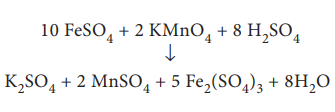with Example - Gram Equivalent Concept | 11th Chemistry : UNIT 1 : Basic Concepts of Chemistry and Chemical Calculations
Chapter: 11th Chemistry : UNIT 1 : Basic Concepts of Chemistry and Chemical Calculations
Gram Equivalent Concept
Gram
Equivalent Concept:
Similar to mole concept gram equivalent concept is also
widely used in chemistry especially in analytical chemistry. In the previous
section, we have understood that mole concept is based on molecular mass.
Similarly gram equivalent concept is based on equivalent mass.
Definition:
Gram equivalent mass of an element, compound or ion is the
mass that combines or displaces 1.008 g hydrogen or 8 g oxygen or 35.5 g
chlorine.
Consider the following reaction:
Zn+H2SO4 → ZnSO4+H2
In this reaction 1 mole of zinc (i.e. 65.38 g) displaces
one mole of hydrogen molecule (2.016 g).
Mass of zinc required to displace 1.008 g hydrogen is

The equivalent mass of zinc = 32.69
The gram equivalent mass of zinc = 32.69 g eq-1
Equivalent mass has no unit but gram equivalent mass has
the unit g eq-1
It is not always possible to apply the above mentioned
definition which is based on three references namely hydrogen, oxygen and
chlorine, because we can not conceive of reactions involving only with those
three references. Therefore, a more useful expression used to calculate gram
equivalent mass is given below.
Gram equivalent mass = Molar mass (g mol-1) /
Equivalence factor (eq mol-1)

On the basis of the above expression, let us classify
chemical entities and find out the formula for calculating equivalent mass in
the table below.
Equivalent Mass of Acids, Bases, Salts, Oxidising Agents and Reducing Agents

Mole concept requires a balanced chemical reaction to find
out the amount of reactants involved in the chemical reaction while gram
equivalent concept does not require the same. We prefer to use mole concept for
non-redox reactions and gram equivalent concept for redox reactions.
For example,
If we know the equivalent mass of KMnO4 and
anhydrous ferrous sulphate, without writing balanced chemical reaction we can
straightaway say that 31.6 g of KMnO4 reacts with 152 g of FeSO4
using gram equivalent concept.
The same can be explained on the basis of mole concept.
The balanced chemical equation for the above mentioned reaction is

i.e. 2 moles (2 × 158 = 316 g) of potassium permanganate
reacts with 10 moles (10 × 152 = 1520 g) of anhydrous ferrous sulphate.

Related Topics